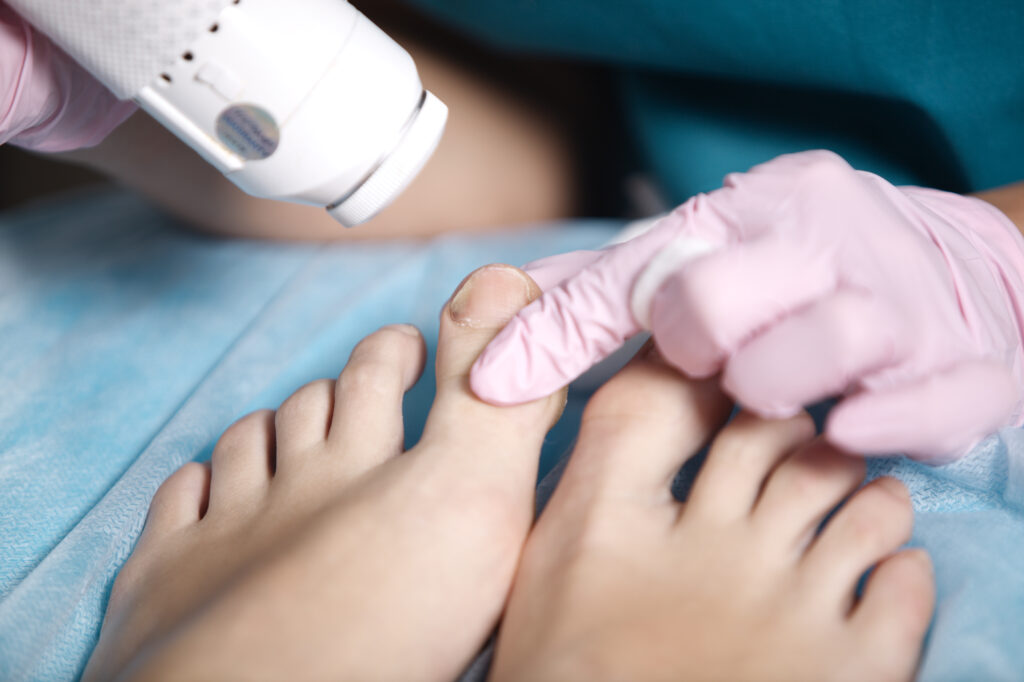
As we go through life, we have to do everything we can to safeguard and protect our health. When we are feeling great, we get to enjoy all the fun and wonder in the world. If, on the other hand, we are facing health challenges we often find we can no longer do everything we love. Toenail fungus can damage your nails, and also cause pain and discomfort that could limit what you can do.
If you are suffering from this condition, it’s helpful to know the pros and cons of laser treatment for toenail fungus. This fungal infection of the nails, known as onychomycosis, can result in your nails becoming brittle, crumbly, thickened or discoloured. These infections can arise from wearing shoes that are sweaty, going barefoot in public areas that are damp or having nails that are cracked. In extreme cases, the toenail might even have a bad smell or separate from the underlying nail bed.
Treating Infected Toenails
It can be difficult to treat infected toenails. Some of the typical remedies are not very effective, and require a long treatment time. Non-prescription and prescription oral remedies have to be taken for two or three months, and may take four months before you see any results. These drugs also have unwanted side effects. Patients looking for a better, and more effective, treatment should look at how effective laser treatment for nail fungus helps.
Laser therapy is an innovative approach that offers effective treatment and takes far less time than traditional remedies. Laser treatment is safe, quick, painless and non-invasive. During the procedure, each nail that is infected will be targeted by a laser for a period of several minutes. The heat of the laser kills the fungus, without causing side effects or affecting healthy tissue.
Pro: Effective and Offers High Precision
Unlike topical treatments that have trouble penetrating the bed of the nail, laser treatment provides a precise, targeted way to get rid of fungal nail infections. The laser directly delivers light energy that is concentrated and can penetrate directly into the tissue affected by the infection.
This deep, focused penetration allows the laser to directly destroy fungal cells that are present, while at the same time leaving nearby healthy tissue untouched and unharmed. Laser treatment programs can have success rates in the sixty to eighty-five percent range, which is much better than results using conventional topical medications.
Pro: Painless and Non-Invasive
One of the advantages of laser treatments is that they are non-invasive. No incisions are required, and most patients being treated report little to no discomfort during the process.
This is a big improvement when compared to anti-fungal medications taken orally, which often have side effects that are systemic. Another traditional process, which involves a surgical removal of the nail, is very painful and may require an extended period of recovery.
Pro: Quick Procedures with Minimal Recovery Time
Typically, a laser treatment for toenail fungus will last about fifteen to thirty minutes. Time will vary depending on the number of toenails being treated.
Once the treatment has been completed, the patient will be able to get back to their everyday activities immediately. The quick procedures and treatment is a big plus when compared to lengthy time duration for oral or topical therapies.
Pro: Greatly Reduce the Risk of Possible Side Effects
The safety profile for using laser treatment for toenail fungus is very positive. This type of therapy is a safer alternative for many patients who may also have other pre-existing health conditions.
Choosing this treatment option also helps patients bypass the side effects of oral medications. Systemic oral pharmaceuticals can cause adverse effects such as gastrointestinal disturbances or even liver toxicity.
Con: Higher Cost
With laser treatments, one of the possible drawbacks relates to the cost of the treatments. Sessions can vary in price, so it’s important to check with your treatment provider. To have optimal results with the laser, it’s also likely that you will need multiple sessions.
Even though laser treatments for toenail fungus are more effective than traditional therapies, some insurance plans may not cover the laser therapy because they have classified it as being a cosmetic procedure. You will want to check with your health insurance provider to find out their policies.
Con: Efficacy Can Be Variable
Laser treatments have shown great promise and are often quite effective when used to treat toenail fungus. The effectiveness of the therapy is not 100 percent guaranteed, though. You’ll want to meet with your health care provider and have discussions that lead you to a realistic expectation of what your results might be.
Multiple factors can affect the outcomes associated with your laser treatments. The specific type of fungus involved, the severity of your infection and the individual response by the patient all play a part in the final outcome.
Con: Availability Might Be Limited
Laser toenail fungus removal is offered by leading podiatry or dermatology clinics that have the technology and the expertise to offer these procedures. It takes specialised skills and training for healers to be able to provide therapy using lasers.
Laser therapies are one of the most promising advances in treating toenail fungus infections. The high-precision laser treatments are minimally invasive and help patients avoid the potential side effects they would face with oral medications. If you are suffering from toenail fungus problems, make an appointment today for laser therapy at one of our podiatry clinics around Brisbane. You can restore the health and well-being of your feet, and be comfortable walking again.

Recent Comments